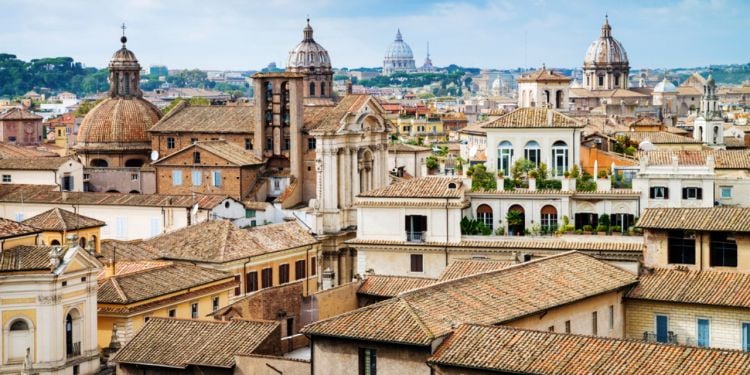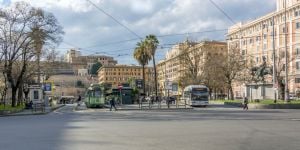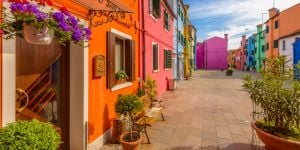
Rome has a complex real estate market, as is the case throughout Italy, and it is not always easy to find a property, especially if you intend to buy. The list of administrative procedures, the costs involved, the sometimes long delays, can be quite discouraging for prospective expats. However, having the right information can make the task less tedious. If your dream is to buy a property in Rome, we will try to give you some useful tips in this article.
The real estate market in Rome
According to a study carried out in November 2022 by Idealista, a leading real estate portal, the price of a square meter for sale corresponds to an average of €3,000 per square meter for the city, with variations depending on the area in which you wish to buy, with the city center reaching an average of €6,000 per square meter, and even €8,000 per square meter for the historical areas such as Piazza Navona, Piazza del Popolo, the Quirinale or those close to the Vatican City.
Still, according to this study, the price per square meter for renting accommodation in Rome would be €14 on average (i.e., a 6.8% rise compared to 2021), with differences depending on the district, such as the historic center, which is the most prestigious and the most expensive (€26/sq.m).
Neighborhoods in Rome
Rome is a large city and is made up of 15 municipi (or neighborhoods), which are divided into rioni (or sub-neighborhoods). Here are the most sought-after rioni for buying a property in Rome:
The historic center
This is a typical, grand and colorful area, such as Campo de Fiori, Piazza Navona, Piazza del Popolo or Piazza di Spagna and their surroundings. The advantage of this area is that you can have everything within walking or cycling distance. But it also has some drawbacks: the flats are generally small, there is little parking space, and there are always a lot of tourists. Still, the famous Trastevere district, which is part of the historic center, has many bars and restaurants and is more suitable for going out with friends.
Parioli
This is one of the quietest and most elegant areas of Rome, with refined buildings and tree-lined streets. Here you will find the famous parks of Villa Borghese, Villa Ada or Monte Mario. The disadvantage of this area of Rome is that it is not well-served by public transport. Another similar but slightly more popular and lively area is Flaminio, near the MAXXI museum.
Prati
Like Parioli, this is an elegant part of the city but much more central, right next to the Vatican, where the pretty Piazza Cavour is located. Prati is well served by public transport, including the metro.
Aventine
Near the Baths of Caracalla, this chic and refined residential area is also home to many Italian celebrities. There are beautiful houses and a wide range of other luxury accommodations. Unfortunately, renting and selling prices in this area are among the most expensive in the capital.
Monti
Monti is the district within walking distance of the Colosseum and the Roman Forums, as well as Termini station, and is served by the B metro line. The area is rich in vintage shops, bars and typical restaurants. It has been a great success in recent years, and housing prices have risen sharply.
Testaccio
This is an old working-class area of Rome that is coming back into fashion and is known for having some of the best restaurants in the city. It is popular with expats and students who want to experience authentic Rome. However, some areas are very lively, even in the evening, with many bars and restaurants.
Monteverde
This leafy suburb is ideal for expats looking for a quiet area close to the center. In addition, it is generally more affordable than the rest of the city.
San Lorenzo
San Lorenzo is a favorite area for students, not least because it is home to one of Rome's most important universities, La Sapienza. The area is also famous for its affordable bars and typical Roman restaurants. San Lorenzo has become popular in recent years for its street art. On the San Lorenzo Art District website, you can see all the artworks (and the names of the artists) that are made in the area.
San Giovanni
This historic area of Rome is famous for the Basilica of San Giovanni in Laterano, one of the largest in the capital. It is easy to get around as it is served by two metro lines, the A and the C, and is ideal for international students in Rome.
EUR
EUR is the newest district of Rome and is easily accessible by metro line B. It has recently developed residential areas, wide wooded avenues and new buildings. But, on the other hand, the area is much more out of the way than the others.
Good to know:
Rome is quite chaotic in terms of traffic and public transport, so it is advisable to stay close to schools if you have children, to the university, or to your workplace to avoid stress and unnecessary delays.
When choosing a neighborhood, be sure to take into account the means of transport in Rome, especially if you choose accommodation outside the center. If you have a car or intend to buy one, be aware that parking can be a headache, and you will have to be patient unless you rent a parking space, as the streets are usually full of vehicles.
Types of accommodation available in Rome
The most common types of accommodation in Rome are flats, with houses being more common in the countryside and by the sea. These flats, however, often have beautiful balconies or, better still, a terrace in the case of a penthouse.
The flats are located in residential buildings, usually on an upper floor, with the ground floor reserved for concierge services or commercial use (restaurants, bakeries, grocery shops, law firms, etc.). The building usually has a lift, a common courtyard and/or garden and cellars.
The different types of flats you can find in Rome are:
- Monolocale: studio apartment (from 25 - 40 m²)
- Bilocale: two-room flat (from 50 - 60 m²), including one bedroom
- Trilocale: three-room flat (from 80 m²), including two bedrooms
- Quadrilocal: four-room flat (from 100 - 120 m²), including three bedrooms
- Attico: penthouse with a terrace, usually of large dimensions
Good to know:
The Roman real estate market has its own particularities, as is the case with the rest of Italy. When leaving their property, some owners sometimes take the equipped kitchen with them, including appliances such as the fridge or the dishwasher. If you wish to benefit from it, you will need to purchase this in addition to the flat or house you are buying.
Pay attention to the square meters advertised by the estate agent. There is a significant difference between living space and commercial space. In general, commercial space also takes into account any balconies, cellars, etc., and, therefore, increases the number of square meters, although these are not livable. Make sure to ask the real estate agent/landlord about it when you visit a property to avoid unpleasant surprises.
You will soon realize that the upper floors of a building are often the most sought-after (which sometimes increases their price), as opposed to the first floors, for reasons such as light and security.
How to find a property to buy in Rome
It's best to plan your search for better access to property offers: ads found on online real estate platforms and real estate agencies.
To get an idea of the prices on the Roman real estate market, you can start your search by checking out property websites such as Idealista, Trovacasa, Casa.it and Immobiliare, which publish numerous ads. You can also receive an alert every time a new property is available on the market. All you have to do is create an account in your name, select different search filters, and provide your e-mail address, and you will receive the relevant ads.
Another important step is to visit one (or more) real estate agency(ies), as buying real estate is complex in the Italian market, so an expert will guide you and provide you with all their knowledge of the city. Real estate agencies in Italy include Remax, Gabetti, Gruppo Immobiliare Coppedè, Tempocasa, Toscano, Link Immobiliare, Romana Servizi Immobiliare and Agenzia Regilla Immobiliare.
Good to know:
Like all major Italian cities, Rome offers many property-finding services. For example, you can hire a property finder to help you find the type of accommodation you are looking for. This specialized real estate agent deals exclusively with clients who wish to buy a property and, based on your briefing, will submit the results of his search to you, whether it be houses, flats, flats, villas, etc. Please note that this kind of premium service has a cost, and the remuneration of this specialist is linked to the outcome of the mediation, in this case, if you buy one of the properties proposed. Therefore, if you use this service, find out beforehand what commissions the property finder charges.
Steps to buying property in Rome
As mentioned in our article "Buying property in Italy", the administrative procedures can be long and tedious. So before you start the process of buying property in Rome, make sure you have some essential documents: your codice fiscale, which must be obtained as soon as you arrive in the country (if not before, at the Italian consulate in your home country), Italian residence certificate, or visa and residence permit if you are not from an EU country, and an Italian tax form.
When you find a property through an estate agent, you will be asked to make a price offer, which the agent will give to the seller. At the same time, it is advisable, if you need financing, to apply for a home loan from a financial institution. However, this can be time-consuming as the bank has to carry out a series of checks on your professional and personal position, as well as on the property, before it can accept your application.
Next, the two parties usually agree on the drafting and signing of a preliminary contract, also known as a preliminary sales agreement (contratto preliminare or compromesso), which the real estate agent, as a mediator, must have registered within 20 days (or 30 days if a notary public is involved). The registration cost with the Agenzia delle Entrate (Italian tax authorities) is €200, regardless of the property's price. It is also customary to pay a deposit on the total sale amount; there is no fixed amount, but you should count on about 10-15%. Please note that through this contract, the parties undertake to sell/purchase the property and to finalize a definitive sales contract, called a contratto di compravendita. The latter is signed before the notary in the presence of all parties.
Good to know:
When making an offer, you can propose a lower price; however, find out about the price of flats in your chosen area in order to offer a reasonable and fair price.
Taxes to pay when buying property in Rome
As a general rule, the taxes to be paid by buyers vary according to the type of property purchased, the assets and the seller. If the seller is an individual or a company not subject to VAT, the taxes will be as follows:
- the registration tax of 9%. If this is your first home, prima casa, this tax is reduced to 2% thanks to a tax break. However, if the property purchased is in a luxury category (A/1, A/8, A/9: historic houses and villas, palaces and castles), you will not benefit from this.
- the mortgage and cadastral tax, in total 100€.
- IMU, Imposta Municipale Propria, if the property purchased is considered a second home (IMU does not apply to the purchase of the first home or main residence)
- the TARI, the waste tax for your home, which you will pay once you have settled in.
Good to know:
In addition to these taxes, at the time of purchase, you may have to add other costs: notary, lawyer, translator, real estate agency commission, which generally range from 2 to 5%, etc.
Things to check when buying a flat in Rome
If you want to own a property in Italy, and in this case in Rome, there are a number of things you need to check before you sign a deed of sale.
Once you have found the property you want to buy, it is essential to obtain the deed of ownership. The estate agent should request this from the seller and provide it to the notary, who will check that the previous property(ies) have passed.
You must then ensure that the property in question is in conformity with the town planning and cadastral regulations. In the deed of sale, the notary will ask the seller to officially confirm that everything is in order in the municipal and land registers (compliance with municipal building/renovation regulations, correct planimetry, etc.).
The certificato di agibilità (declaration of conformity) is also essential in the case of a purchase and will be requested by your bank if you take out a mortgage.
Another document that should be part of the deed of sale is the energy performance certificate, as it gives you an idea of the consumption levels of the property. But, again, the notary should take responsibility for inserting the document into the sales file.
You should also ask for the certificate of conformity of the sanitary and heating installations so that there are no surprises just after your purchase. These are issued by the companies that carry out the construction and/or renovation work.
Finally, in the case of a flat, don't forget to check the amount of the co-ownership charges with the administrator and especially the existence of any debts on the part of the seller.
Useful links :
We do our best to provide accurate and up to date information. However, if you have noticed any inaccuracies in this article, please let us know in the comments section below.












Comments